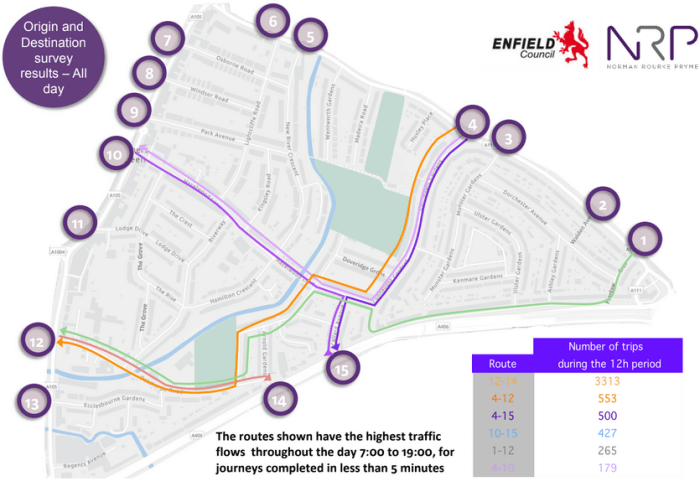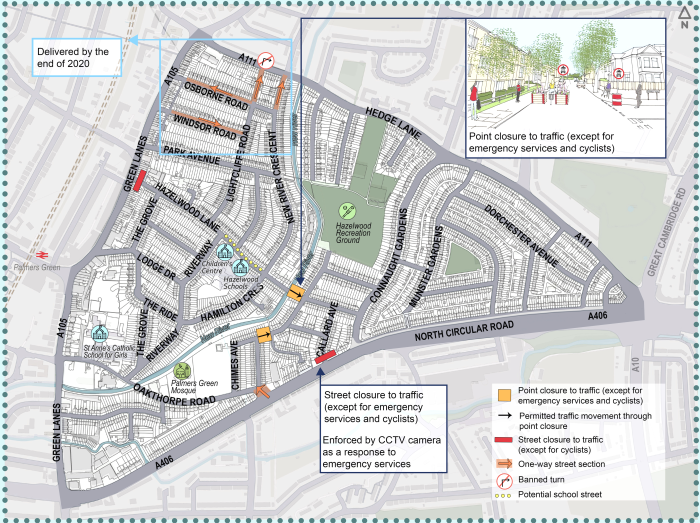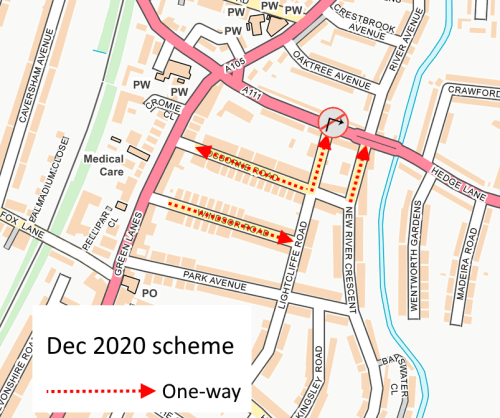Residents for Connaught Gardens LTN is a new group set up to support the proposal to create a low-traffic neighbourhood in Palmers Green to the east of Green Lanes. Below, they set out the reasons why they would like to see all through traffic excluded from the triangular area between Green Lanes, Hedge Lane and the North Circular Road.
Residents for the Connaught Gardens LTN
- Who we are
- Why we support an LTN for the Connaught Gardens area
- What’s the problem?
- What is the council proposing?
- Won’t other roads become more congested?
- What about vulnerable and disadvantaged groups?
- What about access for emergency vehicles?
- What can I do to support the plans?
- Sources and further reading
Who we are
We’re a group of people living within the Connaught Gardens Area Quieter Neighbourhood who support the council’s plan to create a “low-traffic neighbourhood” (LTN) that would prevent drivers from using our neighbourhood as a bypass between surrounding main roads - Green Lanes, Hedge Lane and the North Circular Road.
Why we support an LTN for the Connaught Gardens area
Every day thousands of drivers who don’t live in our area cut through our residential streets to shave a few seconds off their journey times. They do this because they’re in a hurry, so they drive too fast for our narrow streets, filling them with noise and exhaust fumes and making it dangerous for us to cross roads on foot - especially those of us who are young or old.
Once upon a time we could go out for a stroll around our streets and bump into friends doing the same. Our kids could walk, cycle or scoot to school without facing danger every time they came to a street corner and without breathing in noxious fumes that harm their lungs or the miniscule particulates produced by diesel engines that can even penetrate their brains.
If we could just get rid of the cars cutting through our area and keep them to the main roads that are designed for them, the air would be cleaner, there would be less danger and we could once more hear the birdsong as we did during the first lockdown.
The LTN plan would do all this. We’d still be able to drive to and from home, and so would visitors, but we might decide that, with quieter and safer streets, we’d walk or cycle more instead of always driving.
What’s the problem?

A survey by the council last autumn confirmed that there are multiple “rat runs” throughout the area - drivers entering the area and leaving within five minutes. This map is taken from the survey report (which you can download here) and shows only the routes with the heaviest traffic across the day (7am to 7pm).
The worst affected streets are Connaught Gardens, Hazelwood Lane, Oakthorpe Road, Chimes Avenue, Arnold Gardens and Callard Avenue. In the morning rush hour the last two, both short, narrow residential streets, are totally blocked by cars queuing to join the eastbound A406.
What is the council proposing?

To stop drivers cutting through the area the council plans to do the following:
- Close off the western end of Hazelwood Lane and southern end of Callard Avenue. Emergency services would still be able to use Callard Avenue, as access would be controlled using cameras (as has already happened on the bridge in Fox Lane).
- Make the eastern end of Oakthorpe Road one-way so that cars can enter from the A406 but can’t use it to access the A406.
- Create “point-no-entries” in Hazelwood Lane to stop the use of Connaught Gardens to cut across from Hedge Lane to Green Lanes via Hazelwood Lane or Oakthorpe Road.
- Introduce a school street outside Hazelwood Schools and the Children's Centre to protect children (and parents) during school arrival and leaving times.
At the moment the council is only seeking views about the proposals listed above - it doesn’t currently have funding to implement them. However, there is a smaller intervention in the north-west corner of the area that will be carried out before the end of 2020:
- Create a small one-way system in Osborne Road, Windsor Road and parts of Lightcliffe Road and New River Crescent.
This is similar, but not identical, to the temporary one-way system that has been in force since April. It will prevent drivers from using New River Avenue or Lightcliffe Road to enter the area so that they can cut through to Green Lanes or the North Circular.

Once the new one-way system is in place it will be trialled for six months and a formal consultation will be run concurrently. Depending on feedback from residents, at the end of the period it will be made permanent, modified and retrialled, or removed.
Won’t other roads become more congested?
It is a natural assumption that by restricting through-traffic on certain streets traffic will be displaced onto other roads and cause congestion.
But that assumes traffic behaves like water and that if one route becomes blocked another will become flooded.
But when walking and cycling are made safer and more convenient - and the car becomes a little less convenient for short trips - fewer people choose the car.
Some people will stop making particular trips, combine multiple trips into one, change destination, travel at a less congested time, or switch to public transport, walking or cycling.
This is known as 'traffic evaporation' and has been documented all over the world.
Even with traffic evaporation, main roads will shoulder some extra traffic but evidence suggests the impact of this isn't as big as some fear.
In Waltham Forest for example, research showed that bus journey times on main roads have not significantly increased following the introduction of LTNs.
Main roads are designed to take the majority of traffic, so can absorb increases in traffic better than residential streets. They have wider carriageways, with buildings set further back. They also have better crossing facilities and safer junctions.
A small increase in traffic on a main road is less noticeable than the transformation brought about by a dramatic reduction of traffic on a residential street.
What about vulnerable and disadvantaged groups?
Residential streets full of impatient drivers cutting through or lines of idling traffic are hostile not only to children and their parents, but to grandparents and the elderly and infirm too. With limited mobility, many elderly residents (or those with disabilities) spend their lives more locally – and they deserve clean air and safe streets as much as anyone. The streets will be much safer for a frail or disabled person to cross a road at their own pace, and for those who want to use a bike, trike or mobility scooter as a mobility aid.
Anyone who needs to travel by car or taxi will still be able to. Mobility scooters will be able get through the filters that stop cars. Since vehicles can still enter every street, there is no problem with retaining designated disabled parking bays.
Reducing traffic has been shown to boost communities in neighbourhoods; low traffic means more people are likely to consider their neighbours as friends (Donald Appleyard has famously studied this). The elderly could especially benefit from a stronger community on their street.
What about access for emergency vehicles?
The council is obliged by law to consult with the emergency services about any road changes and to adjust their plans. In the case of Connaught Gardens LTN conditions for emergency services will be improved compared with now.
There will be only one new physical blockage, at the Green Lanes end of Hazelwood Lane, but emergency services will be able to use nearby Park Avenue instead. They will have much easier access from the North Circular than now, as they will not have to contend with traffic queuing at the ends of Callard Avenue and Oakthorpe Road (there will be no physical barrier at the end of Callard Avenue, only cameras). Within the area all roads will have much less traffic, reducing delays to emergency services.
What can I do to support the plans?
Tell the council what you think
The council intend to create the main part of the low-traffic neighbourhood once it receives funding from Transport for London - it’s unclear when this will be. At the moment they are engaging informally with the public.
If you would like to see an LTN, this is your chance to help bring it about.
- Click here to go to full information about the scheme on the Let’s Talk Enfield website.
- Fill in the council survey
You can also let your councillors know what you think:
Include deputy council leader Ian Barnes: .
Click on this link to send an email to all four.
You don’t need to live within the Connaught Gardens area to comment. For instance, you might visit people living there, or travel through it on foot or bicycle. Or your street, although outside the area, might benefit. For example, many of the cars using Powys Lane and Broomfield Lane continue along Oakthorpe Road to the North Circular, using this route as a sort of “North Circular Bypass”. The LTN would close off this route and make them use the A406, reducing traffic in Powys Lane and Broomfield Avenue.
Find the email addresses of councillors in other wards
Get in touch with Residents for the Connaught Gardens LTN
If you would like to join our group, please get in touch by filling in this form or by emailing .Sources and further reading
- Low Traffic Neighbourhoods: an introduction to policy makers
- A Guide to Low Traffic Neighbourhoods (for more nitty gritty detail)
- Evidence from Waltham Forest
- Disappearing traffic: the story so far
- What’s up with that: Building Bigger Roads Actually Makes Traffic Worse
- Surprise: Bike-friendly Netherlands named best place in the world to be a driver
- Evaporating traffic? Impact of low-traffic neighbourhoods on main roads
- Wheels for Wellbeing: publications and research
- Fairness in a Car-dependent Society – Sustainable Development Commission



